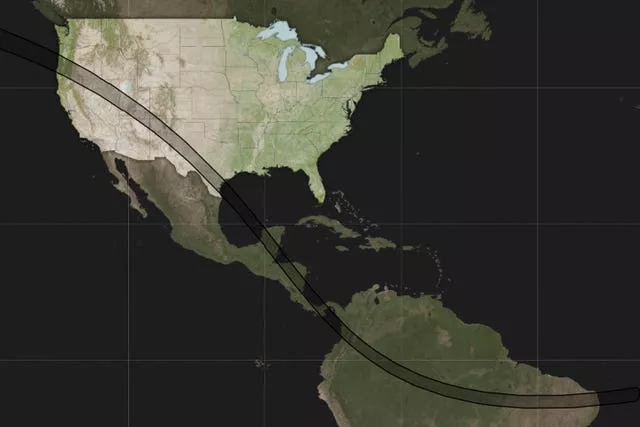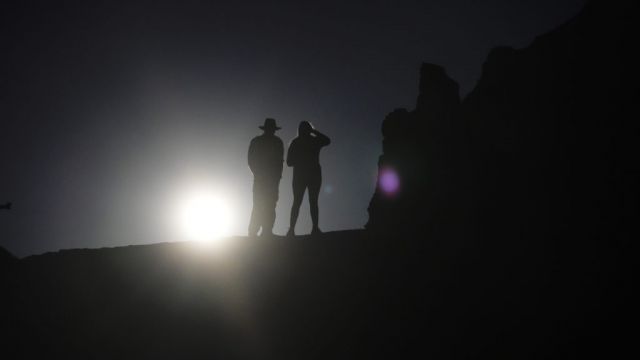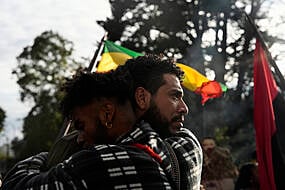A partial solar eclipse of the sun, the first stage of a rare “ring of fire” eclipse that is expected to cut across the Americas, has begun to emerge.
Nasa’s livestream of the phenomenon showed the moon starting to cover the sun in Eugene, Oregon, shortly after 8am local time (4pm BST).
For the small towns and cities along its narrow path, there was a mix of excitement, worries about the weather and concerns they would be overwhelmed by visitors flocking to see the celestial event, also called an annular solar eclipse.
Come watch the eclipse with us!
We're streaming today's "ring of fire" eclipse—also known as an annular solar eclipse—with live updates from Oregon to Texas. #AskNASA your questions! https://t.co/m69JrxrMKS https://t.co/CRMmOdx9Fg— NASA (@NASA) October 14, 2023
Advertisement
Clouds and fog have threatened to obscure the view of the eclipse in some western states, including California and Oregon.
Unlike a total solar eclipse, the moon does not completely cover the sun during a ring of fire eclipse. When the moon lines up between the Earth and the sun, it leaves a bright, blazing border.
Members of a crowd at the Eugene Science Centre in Eugene, Oregon, were desperately wishing for the clouds on the horizon to clear. Dozens of people set up telescopes and cameras with special filters in the hopes of capturing the celestial event.
Shuumei Kodama, 11, woke up at 4.30am to make the drive from Portland, Oregon, with his father. Eclipse glasses in hand, he explained that he’s been obsessed with space since he was five.
“It seems like one of the coolest things I’ve ever heard of,” he said of the annular eclipse. “I want to see every type of eclipse possible one day. That’s my goal.”
The path of the eclipse is: Oregon, Nevada, Utah, New Mexico and Texas in the US, with a sliver of California, Arizona and Colorado.

Next: Mexico’s Yucatan Peninsula, Belize, Honduras, Nicaragua, Costa Rica, Panama, Colombia and Brazil. Much of the rest of the Western Hemisphere gets a partial eclipse.
The celestial event brought eclipse watchers from around the US to remote corners of the country to try to get the best view possible.
At Bryce Canyon national park in southern Utah tiny lights could be seen along a well known trail that snakes through a valley of red rock hoodoos as eclipse enthusiasts hit the trail before sunrise to stake out their preferred spot
“I just think it’s one of those things that unites us all,” said John Edwards, a cancer drug developer who travelled alone across the country to try to watch the eclipse from Bryce Canyon. “I just think it’s seeing these unique experiences that come rarely is what got me here. This is about as rare as it gets.”

Viewing all depends on clear skies – part of the US path could see clouds. Nasa and other groups plan to livestream the event.
Tens of thousands were getting a double treat in Albuquerque, New Mexico, where the eclipse coincided with an international balloon fiesta that draws close to 100,000 spectators for early morning mass ascensions of hundreds of colourful hot air balloons.
Organisers gave out 80,000 pairs of viewing glasses on Saturday morning.
Allan Hahn of Aurora, Colorado, has been attending the festival for 34 years, first as a crew member and then as a licensed balloon pilot.
His balloon, Heaven Bound Too, was one of 72 selected for a special “glow” performance as skies darken during the eclipse, where pilots use their propane burners to light up their balloons on the field.
“It’s very exciting to be here and have the convergence of our love of flying with something very natural like an eclipse,” he said.
Viewers on the US East Coast were prepared to see less of the event – close to a quarter eclipse around midday in some areas, such as New York City – but were nonetheless geared up to watch the skies.
In Maine, viewers expected to see only about 12% of the sun covered, but the Clark Telescope on the grounds of the Versant Power Astronomy Centre at the University of Maine was open to the public.







